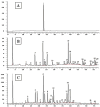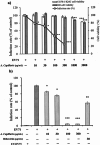Artemisia capillaris inhibited enterovirus 71-induced cell injury by preventing viral internalization
- PMID: 29475462
- PMCID: PMC11915635
- DOI: 10.1016/j.kjms.2017.11.005
Artemisia capillaris inhibited enterovirus 71-induced cell injury by preventing viral internalization
Abstract
Artemisia capillaris (A. capillaris) is a common herbal drug used for thousands years in ancient China. A. capillaris has been empirically used to manage hand-foot-mouth disease (HFMD), which is commonly caused by enterovirus 71 (EV71). EV71 can cause meningoencephalitis with mortality and neurologic sequelae without effective management. It is presently unknown whether A. capillaris is effective against EV71 infection. To test the hypothesis that it could protect cells from EV71-induced injury, a hot water extract of A. capillaris was tested in human foreskin fibroblast cells (CCFS-1/KMC) and human rhabdomyosarcoma cells (RD cells) by plaque reduction assay and flow cytometry. Inhibition of viral replication was examined by reverse quantitative RT-PCR (qRT-PCR). Its effect on translations of viral proteins (VP0, VP1, VP2, protease 2B and 3AB), and apoptotic proteins were examined by western blot. A. capillaris was dose-dependently effective against EV71 infection in both CCFS-1/KMC cells and RD cells by inhibiting viral internalization. However, A. capillaris was minimally effective on viral attachment, VP2 translation, and inhibition of virus-induced apoptosis. Further isolation of effective molecules is needed. In conclusion, A. capillaris has anti-EV71 activity mainly by inhibiting viral internalization. A. capillaris would be better to manage EV71 infection in combination with other agents.
Keywords: Alternative therapy; Gan-Lu-Siao-Du-Yin; TCM; Traditional Chinese medicine.
Copyright © 2017 Kaohsiung Medical University. Published by Elsevier Taiwan. All rights reserved.
Figures






Similar articles
-
Gan-Lu-Siao-Du-yin, a prescription of traditional Chinese medicine, inhibited enterovirus 71 replication, translation, and virus-induced cell apoptosis.J Ethnopharmacol. 2016 Jun 5;185:132-9. doi: 10.1016/j.jep.2016.03.034. Epub 2016 Mar 16. J Ethnopharmacol. 2016. PMID: 26993050
-
Flos Farfarae Inhibits Enterovirus 71-Induced Cell Injury by Preventing Viral Replication and Structural Protein Expression.Am J Chin Med. 2017;45(2):299-317. doi: 10.1142/S0192415X17500197. Epub 2017 Feb 23. Am J Chin Med. 2017. PMID: 28231741
-
Glycyrrhizic acid as the antiviral component of Glycyrrhiza uralensis Fisch. against coxsackievirus A16 and enterovirus 71 of hand foot and mouth disease.J Ethnopharmacol. 2013 May 2;147(1):114-21. doi: 10.1016/j.jep.2013.02.017. Epub 2013 Feb 27. J Ethnopharmacol. 2013. PMID: 23454684 Free PMC article.
-
Yakammaoto inhibits enterovirus 71 infection by reducing viral attachment, internalization, replication, and translation.Kaohsiung J Med Sci. 2015 Jun;31(6):293-302. doi: 10.1016/j.kjms.2015.02.008. Epub 2015 May 7. Kaohsiung J Med Sci. 2015. PMID: 26043408 Free PMC article.
-
Recent Progress on Functional Genomics Research of Enterovirus 71.Virol Sin. 2019 Feb;34(1):9-21. doi: 10.1007/s12250-018-0071-9. Epub 2018 Dec 14. Virol Sin. 2019. PMID: 30552635 Free PMC article. Review.
Cited by
-
Research progress on antiviral constituents in traditional Chinese medicines and their mechanisms of action.Pharm Biol. 2022 Dec;60(1):1063-1076. doi: 10.1080/13880209.2022.2074053. Pharm Biol. 2022. PMID: 35634712 Free PMC article.
-
The Pharmacological Effects and Pharmacokinetics of Active Compounds of Artemisia capillaris.Biomedicines. 2021 Oct 8;9(10):1412. doi: 10.3390/biomedicines9101412. Biomedicines. 2021. PMID: 34680529 Free PMC article. Review.
-
Antiviral activity of silymarin in comparison with baicalein against EV-A71.BMC Complement Med Ther. 2020 Mar 23;20(1):97. doi: 10.1186/s12906-020-2880-2. BMC Complement Med Ther. 2020. PMID: 32293397 Free PMC article.
-
Advances in anti-EV-A71 drug development research.J Adv Res. 2024 Feb;56:137-156. doi: 10.1016/j.jare.2023.03.007. Epub 2023 Mar 30. J Adv Res. 2024. PMID: 37001813 Free PMC article. Review.
References
-
- Zhang G.L., Li Z.G., Tong J.B., Shang L.L., Luo C.C.. A review of Chinese traditional prescriptions used in treatment and prevention of hand, foot and mouth disease. J Tradit Chin Med. 2010; 22: 574–582.
-
- Cohen J.I.. Enterovirus, Parechovirus, and Reovirus infections. In Kasper D., Fauci A., Hauser S., Longo D., Jameson J.L., Loscalzo J., eds. Harrison's principles of internal medicine. 19 ed. New York: McGraw‐Hill. 2015, [Chapter 228].
-
- McMinn P.C.. An overview of the evolution of enterovirus 71 and its clinical and public health significance. FEMS Microbiol Rev. 2002; 26: 91–107. - PubMed
-
- Solomon T., Lewthwaite P., Perera D., Cardosa M.J., McMinn P., Ooi M.H.. Virology, epidemiology, pathogenesis, and control of enterovirus 71. Lancet Infect Dis. 2010; 10: 778–790. - PubMed
MeSH terms
Substances
LinkOut - more resources
Full Text Sources
Other Literature Sources
Miscellaneous

